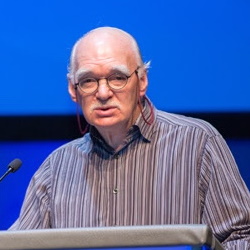Links to external sources may no longer work as intended. The content may not represent the latest thinking in this area or the Society’s current position on the topic.
Causes of obesity: theories, conjectures and evidence

Scientific discussion meeting organised by Professor John R Speakman FMedSci FRS, Professor Thorkild IA Sørensen, Dr Kevin D Hall and Professor David B Allison.
Obesity has been described by the WHO as the largest health threat facing mankind. Obesity is manifestly an issue of energy balance. Yet, there is surprisingly little consensus about why such energy imbalance develops. This meeting included presentations by world experts on the plethora of ideas about the mechanisms underlying obesity, and hence how we may tackle it.
The schedule of talks and speaker biographies are available below. Speaker abstracts are also available below. A related journal issue has been published in Philosophical Transactions of the Royal Society B: Part 1 and Part 2.
Attending this event
This event has taken place.
Enquiries: contact the Scientific Programmes team
Click watch on YouTube to view the full video playlist.
Organisers
Schedule
Chair

Professor John R Speakman FMedSci FRS, Shenzhen Institutes of Advanced Technology, China and University of Aberdeen, UK

Professor John R Speakman FMedSci FRS, Shenzhen Institutes of Advanced Technology, China and University of Aberdeen, UK
John Speakman is a Professor at the Shenzhen Institutes of Advanced Technology in Shenzhen, China and also at the University of Aberdeen in Scotland, UK. He has been working on energy balance and obesity for more than 40 years. During that time he published over 600 scientific papers including 11 in Nature/Science, and was featured twice on the cover of Nature. He is a foreign member of the US National Academy of Sciences, an academician of the Chinese National Academy of Sciences and a Fellow of the UK Royal Society. In 2020 he was awarded the US Obesity Society TOPS award (their premier research award) and was also awarded the Osborne-Mendel prize by the American Society of Nutrition for basic research.
| 08:00 - 08:10 | Welcome and introduction |
|---|---|
| 08:10 - 08:25 |
The genetic subtyping of obesity
Obesity is a multifactorial disease, resulting from an intricate interplay between genetic and environmental factors. Yet, it is defined by a simple metric; ie a body mass index (BMI) of 30 kg/m2 or more. Because of the simplicity of this metric, it is no surprise that obesity is a heterogenous condition. Two individuals that have obesity may differ in the underlying causes of their weight gain. They may also differ in the presentation of disease, its prognosis, the complications, and the response to treatment. To account for this heterogeneity, there is a growing interest to subclassify obesity in smaller, more homogenous subtypes. So far, subclassifications have been predominantly performed based on clinical features in individuals that have obesity (ie phenotypic subclassification). With the increasing number of genetic variants associated with obesity, genetic subclassification has become possible. A key advantage of subclassifications that are based on genetic variants is that they may reveal new insights in the etiology of the disease and its subtypes. In addition, genetic subclassification can be done early on in life, before the onset of disease, allowing for a timely prevention. Professor Loos will review various approaches to implement genetic information in the subclassification of obesity and will discuss how these subtypes may help reveal new biological pathways. A more precise diagnosis is key to more precise prevention and treatment strategies tailored to the specific subtype, more precise prediction of the obesity subtypes, and more precise prognosis. 
Professor Ruth Loos, Novo Nordisk Foundation Center for Basic Metabolic Research, Faculty of Health and Medical Science, University of Copenhagen, Copenhagen, Denmark and Icahn School of Medicine at Mount Sinai, USA

Professor Ruth Loos, Novo Nordisk Foundation Center for Basic Metabolic Research, Faculty of Health and Medical Science, University of Copenhagen, Copenhagen, Denmark and Icahn School of Medicine at Mount Sinai, USARuth Loos is a Vice Executive Director and Group Leader at the Novo Nordisk Foundation Center for Basic Metabolic Research, University of Copenhagen. She is also a part-time professor at the Icahn School of Medicine at Mount Sinai in New York. Her research focuses on the etiology of obesity and on the identification of genes and genetic loci contributing to the risk of obesity and related traits. By identifying genes, Professor Loos aims to gain insight into the biology that underlies body weight regulation and the mechanisms that link adiposity to its comorbidities. With the GIANT (Genetic Investigation of ANTropometric traits) consortium, she has contributed to the majority of large-scale gene-discovery efforts that thus far have revealed many obesity-associated loci. Furthermore, Professor Loos studies more refined adiposity phenotypes and biomarkers to target the deeper layers that define 'obesity' and to fully capture all aspects of the biology involved. Besides gene-discovery, Professor Loos uses epidemiological methods to assess the role of genetic information in precision medicine of common obesity by examining its value in identifying subtypes of obesity, in predicting who is at risk of gaining weight, and in tailoring prevention and treatment strategies. |
| 08:25 - 08:40 | Discussion |
| 08:40 - 08:55 |
Insights from the genetics of obesity and thinness
Family, twin and adoption studies have consistently shown that body weight is a highly heritable trait. Genome wide association studies have identified hundreds of genetic regions or loci containing common variants which are associated with increased body mass index (BMI) or obesity in multiple populations. In addition, disruption of a single gene is sufficient to cause severe obesity which can present in childhood. The discovery and characterization of these monogenic obesity syndromes in mice and humans has paved the way for understanding the molecular framework which underpins appetite and weight regulation by establishing a key role for the leptin-melanocortin pathway. Several of these disorders can now be treated with rational mechanism based therapies. Genetic factors also contribute to protection from obesity and persistent thinness. New genetic discoveries continue to provide insights into the mechanisms which couple weight regulation to other aspects of physiology and behaviour and reveal molecular targets for weight loss therapy. 
Professor I Sadaf Farooqi FMedSci FRS, University of Cambridge, UK

Professor I Sadaf Farooqi FMedSci FRS, University of Cambridge, UKSadaf Farooqi is a Wellcome Principal Research Fellow and Professor of Metabolism and Medicine at the University of Cambridge, UK. She is an internationally leading Clinician Scientist who has made seminal contributions to understanding the genetic and physiological mechanisms that underlie obesity and its complications. The work of Sadaf Farooqi and her colleagues has fundamentally altered the understanding of how body weight is regulated. With colleagues, she discovered and characterised the first genetic disorders that cause severe childhood obesity and established that the principal driver of obesity in these conditions was a failure of the control of appetite. Her work is often cited as an exemplar of how the translation of research into the mechanisms of disease can lead to patient benefit. She has received a number of awards including the ADA Outstanding Scientific Achievement Award 2019 and the Dale Medal 2021 (the highest honour awarded by the UK Society of Endocrinology). In 2021, she was elected as a Fellow of the Royal Society in recognition of her exceptional contribution to science. |
| 08:55 - 09:10 | Discussion |
| 09:10 - 09:25 |
Genetic variants and human diseases: lessons from FTO
Genetic variants associated with complex traits are often in noncoding sequences. Translating these association studies to mechanistic insights into disease has lagged behind. Challenges for the functional follow up of GWAS include: 1) identifying causal variants; 2) establishing the regulatory potential of causal variants; 3) assigning target gene(s); 4) characterizing the phenotypic impact of the variants. The group has developed a comprehensive pipeline to functionally follow up on GWAS signals and used it to dissect loci associated with metabolic traits. Insights from these studies include: 1) the target genes of genetic associations are often far from the causal variants; 2) several variants may contribute to the association on a given locus; 3) multiple regulatory elements harboring variants in a locus may be associated with a trait; 4) these regulatory elements have complex spatial and temporal specificities; 5) multiple genes are often targeted by a single regulatory variant. In this talk Professor Nóbrega will discuss some of the lessons that they learned by dissecting the strongest genetic association with polygenic human obesity, within the gene FTO. Their data posit that the genetic architecture of complex traits may be significantly more complex than previously anticipated, involving pleiotropism, allelic heterogeneity and temporal-specific phenotypic effects of genetic variants. 
Professor Marcelo A Nóbrega, University of Chicago, USA

Professor Marcelo A Nóbrega, University of Chicago, USAMarcelo Nobrega is a professor in the Department of Human Genetics and Dean of Faculty Affairs at the University of Chicago. He is an elected member of the American Society for Clinical Investigation, the American Association of Physicians and a fellow of the American Association for the Advancement of Science. The Nobrega lab is interested in understanding the mechanisms by which noncoding genetic variation lead to phenotypic variation. Focusing on metabolic phenotypes, they have developed strategies to experimentally following-up on genetic leads from genome-wide association studies. |
| 09:25 - 09:40 | Discussion |
| 09:40 - 10:00 | Coffee |
| 10:00 - 10:15 |
Body weight regulation from Lavoisier to control theory
Animal energetics began in 1780, when Antoine Lavoisier and Pierre-Simon Laplace, using an apparatus combining direct and indirect calorimetry, discovered that respiration and combustion are quantitatively identical oxidative processes. By the mid-19th century it was realized that oxidation and physical activity were forms of a conserved quantity, energy. This permitted the (much later) formulation of the energy balance equation: energy stored = energy intake – energy expenditure. Claude Bernard and Walter Cannon developed the concept of homeostasis, that animals actively preserve or regulate many characteristics of the cellular environment within narrow limits despite changes in the outer world. Application of this concept to energy exchange developed slowly. John Brobeck (1948) first reviewed food intake, physical activity, heat loss, and weight change as interconnected variables, but did not argue for regulation. Gordon Kennedy (1951) found that “the young rat adjusts its food intake so precisely to its energy needs that its fat stores remain almost constant” – organismic energy homeostasis. A similar regulatory mechanism exists in humans. In 1868 James Clerk Maxwell published a mathematical analysis of the dynamics of the centrifugal governor that regulated the speed of James Watt’s steam engine. This began negative-feedback control theory. In control-theory models of weight regulation, changes in adipose-tissue mass (the regulated variable) are sensed (negative feedback), activating compensatory control responses that oppose the changes; the strength of these responses (feedback gain) typically determines the dynamics and precision of regulation. Such models can provide useful insights into human weight regulation. 
Professor (Retired) Nori Geary, Weill Cornell Medical College, USA

Professor (Retired) Nori Geary, Weill Cornell Medical College, USAFollowing studies at Harvard College (BA, 1969) and Brown University (PhD, 1978), Dr Geary received an Alexander von Humboldt Foundation fellowship for research with Professor Erwin Scharrer at the Institute of Veterinary Physiology, Ludwig Maximilian University of Munich and subsequently did further postdoctoral work with Professor Gerard P Smith in the Department of Psychiatry, Weill Cornell Medical College, New York. In 1982 he joined the faculty of the Department of Psychology of Columbia University, New York, and in 1992, returned to Weill Cornell Medical College. He was jointly appointed at the Institute of Food, Nutrition and Health, ETH Zürich, from 2004 until retirement in 2012. He received the Distinguished Career Award of the Society for the Study of Ingestive Behavior (SSIB) in 2013. Dr Geary’s research interests centered on neuroendocrine controls of appetite and body weight, in particular the roles of pancreatic glucagon, cholecystokinin and estrogens in satiation. |
| 10:15 - 10:30 | Discussion |
| 10:30 - 10:45 |
Adipocyte and lipid turnover in human adipose tissue
Obesity, defined as an excessive accumulation of body fat, is considered one of the major health challenges facing the world today. White adipose tissue (WAT) mass is determined by the synthesis and removal (ie turnover) of adipocytes and triglycerides. Using a radiocarbon dating strategy the group has shown previously that approximately 10% of subcutaneous abdominal adipocytes are renewed each year throughout adult life. Using the same strategy to measure triglyceride age, they reveal changes in lipid turnover in association with person age, body fat distribution and disease. What has been learned about fat cell and lipid turnover from radiocarbon dating studies, as well as new data on fat cell turnover in omental versus subcutaneous WAT, will be discussed. To explore the implication of these results on the wider issues of energy balance, the group uses a computational model built from an energy-based model (EBM, Hall et al. 2011), which they augment to include physiological regulation as proposed in the carbohydrate-insulin model (CIM, Ludwig et al. 2021), and lipid turnover dynamics. This computational approach will be used to investigate how lipid turnover sets limits on energy partitioning. 
Dr Kirsty Spalding, Karolinska Institutet, Sweden

Dr Kirsty Spalding, Karolinska Institutet, SwedenDr Spalding received her PhD in neuroscience from the University of Western Australia in the School of Anatomy and Human Biology. Following an Ambassadorial Academic Scholarship to Sweden, Dr Spalding completed a postdoctoral fellowship in the Department of Cell and Molecular Biology, where she is currently a Principal Investigator. Dr Spalding’s research focuses on properties of human adipose tissue, with particular attention to adipocyte biology. Basic functions, such as adipocyte lipid and cell turnover, fat cell responses to obesity and hyperinsulinemia and cellular heterogeneity are investigated. Understanding the cell biology and heterogeneity of adipocytes in human adipose tissue, with the ultimate aim of understanding their contribution to health and pathology, is a major focus of the group. Recognition for her work includes being recipient of an ERC Young Investigator award, Vallee Foundation Young Investigator Award, Fernströms prize in Medicine, Novo Nordisk Excellence award, Marie Curie Outgoing Fellowship award and Sven and Ebba Hagberg prize for medicine. |
| 10:45 - 11:00 | Discussion |
| 11:00 - 11:15 |
A unifying pathway for obesity mediated by fructose metabolism
Fructose is a unique nutrient that when metabolized by fructokinase C (KHK) activates an energy depletion pathway that resets ATP levels to a lower intracellular level. This process is mediated by an acute consumption, followed by a removal of the AMP substrate by AMP deaminase, with the generation of intracellular uric acid that induces mitochondrial oxidative stress that reduces ATP production coupled with further blockade of ATP by inhibition of AMP-activated protein kinase. This sets off an ‘alarm signal’ that triggers a survival response in which food and water intake are stimulated, calories are preferentially stored, insulin resistance is induced to reduce energy needs, and circulation and excretion are facilitated by increases in systemic and glomerular hydrostatic pressures, respectively. The mechanism stimulating fructose intake includes taste, palatability and craving, but the critical factor driving excess food intake is leptin resistance. Indeed, increased energy intake is primarily responsible for weight gain and reduced energy metabolism plays a minor role. However, other metabolic effects of fructose, such as its ability to induce insulin resistance, hypertriglyceridemia, hypertension and fatty liver occur independently of excessive calories. Fat has a critical role in the process by being the primary food driving weight gain, but only if leptin resistance from fructose is present. While much of the fructose is from the diet, fructose is also generated in the body in response to high glycemic carbs and salty foods, and some umami foods can also activate the survival switch distal to fructose. Indeed, studies suggest a major role for high glycemic carbs in initiating the switch, while fat is a driver of the obese response. Another factor that has not been recognized until recently is the key role of salt in activating the switch, and the critical role for vasopressin in driving obesity through the V1b receptor. Furthermore, several thrifty genes have been identified that can explain why humans are so sensitive to fructose. Finally, new studies suggest that the endogenous fructose pathway may have a critical role in other conditions, including heart disease, obesity-associated cancer, behavioral disorders and dementia. Ultimately, the fructose pathway appears to have a central role in biology and may help explain many of today’s burden-of-life diseases. It also bridges most of the current hypotheses on obesity. 
Professor Richard Johnson, University of Colorado, USA

Professor Richard Johnson, University of Colorado, USARichard J Johnson, MD is a Professor of Medicine at the University of Colorado, is a practicing physician and has been a medical scientist for over 25 years. He is internationally recognized for his work on the role of sugar and its component fructose, in obesity and diabetes. His work has also suggested a fundamental role for uric acid (which is generated during fructose metabolism) in the metabolic syndrome. Dr Johnson is a prolific scientist with research that has been funded by the National Institute of Health since the 1980s. He has published over 800 papers, lectured in over 45 countries, and his work is highly cited. He also has recently authored a book, Nature Wants Us to Be Fat, for the general readership. |
| 11:15 - 11:30 | Discussion |
Chair

Dr Kevin D Hall, National Institute of Diabetes and Digestive and Kidney Diseases, USA

Dr Kevin D Hall, National Institute of Diabetes and Digestive and Kidney Diseases, USA
Dr Kevin Hall received his PhD in Physics from McGill University and is now a tenured Senior Investigator at the National Institute of Diabetes & Digestive & Kidney Diseases (NIDDK), one of the National Institutes of Health (NIH) in Bethesda, MD. His main research interests are the regulation of food intake, macronutrient metabolism, energy balance, and body weight. Dr Hall has twice received both the NIH Director’s Award and the NIDDK Director’s Award, and is the recipient of the E.V. McCollum Award from the American Society for Nutrition, the Lilly Scientific Achievement Award from The Obesity Society, and the Guyton Award for Excellence in Integrative Physiology from the American Society of Physiology.
| 12:30 - 12:45 |
Sex hormones impact ALL aspects of metabolism
Oestrogens regulate key features of metabolism including food intake, body weight, energy expenditure, insulin sensitivity, leptin sensitivity, and body fat distribution. The metabolic impact of excess body weight is correlated with the location of fat deposition. The abdominal (visceral) fat depot correlates with diseases associated with obesity while fat deposition in the subcutaneous (SC) depot, by comparison, is relatively benign. Of particular interest is the observation that distribution of body fat varies greatly between men and women. On average, women carry more fat in the SC depot; whereas, men carry more fat abdominally. Hence, there are sex differences with regard to obesity-associated health risks, men being more likely to develop cardiovascular disease, diabetes, and other obesity-related disorders. Given the sexual dimorphism in body fat distribution and co-morbidities, it is likely the mechanisms that regulate body fat compartmentalization are controlled by sex hormones. The group and others have generated data indicating oestrogen receptors (ERs) in the central nervous system (CNS) and directly on adipocytes play important roles in determining fat distribution. Importantly, sympathetic nervous system (SNS) activity has been implicated as a key determinant in body fat deposition. There are two ‘classical’ oestrogen receptors (ERs): oestrogen receptor alpha (ERS1) and oestrogen receptor beta (ERS2). Data further implicate ERS1 in specific postganglionic neurons innervating visceral and SC fat depots is distinct, suggestive of neuroanatomical differences in the regulation of fat compartmentalization populations as being critical for regulating body fat distribution and adipose tissue function. This presentation will focus on how oestrogens regulate the trafficking of sympathetic outflow between fat depots, as well as mechanisms underlying divergent SNS circuits from brain to adipose tissues. 
Professor Deborah Clegg, Texas Tech Health Sciences Center, USA

Professor Deborah Clegg, Texas Tech Health Sciences Center, USADr Clegg is a known expert in the field of sex hormones and metabolism with a specific interest in nutrition and how it interacts with physiology. She has authored over 150 articles in impactful journals such as The New England Journal of Medicine, JAMA, American Journal of Physiology, and the National Kidney Foundation. She started her career as a clinical dietitian and in this role, she has advocated for personalized nutritional approaches and liberalization of diets to enhance patient compliance and satisfaction. Dr Clegg is the Vice President for Research at the Paul Foster School of Medicine/Texas Tech Medical School in El Paso, Texas. Dr Clegg and her research has been featured in many forms of media, to include the television program The View, and HBO series entitled Weight of the Nation, as well as in the popular press to include magazines such as Vogue, Mademoiselle, Ladies Home Journal and Nature. Dr Clegg has been instrumental in being a champion for the importance of inclusion of sex and gender in all aspects of research. She is invited to present and review grants nationally and internationally on this topic, and therefore is considered a leading expert on this subject matter. Dr Clegg is passionate about research, passionate about advancing science and medicine with a personalized approach, passionate about advocating for women in science, and passionate about helping others obtain their research interests and potential! |
|---|---|
| 12:45 - 13:00 | Discussion |
| 13:00 - 13:15 |
Is there a role for higher cognitive functions in the development of obesity?
Cognition underpins the flexibility of human eating and disruption to higher cognitive processes, such as inhibitory control and memory, can result in increased food intake, which in the long term could result in weight gain. The aim of this presentation is to provide an overview of the current evidence on the role higher cognitive processes in the development of obesity. Evidence from meta-analyses supports the suggestion that cognitive function is cross-sectionally associated with obesity even when controlling for a range of confounding variables. However, this association could be explained by reverse causality because there is also evidence that metabolic syndrome and a history of excess western diet consumption alters brain structure and cognitive function. Emerging longitudinal data from large childhood cohorts support a causal effect of cognition on the development of obesity but the effect sizes are small and data is currently lacking on the mechanisms that link cognitive process to specific styles or patterns of consumption and subsequent weight gain. It is concluded that higher cognitive functions likely contribute to development of obesity but exactly how, for whom, and the relative importance of the causal association remain to be determined. 
Professor Suzanne Higgs, University of Birmingham, UK

Professor Suzanne Higgs, University of Birmingham, UKProfessor Suzanne Higgs has a degree in Psychology, Philosophy and Physiology from the University of Oxford and a PhD in Psychology from Durham University. She worked as a Post-Doctoral researcher at the University of Oxford before taking up a faculty position in the School of Psychology at the University of Birmingham. Suzanne leads a research group interested in the psychobiology of eating. She is a Past President of the Society for the Study of Ingestive Behavior and Editor in Chief of Appetite. |
| 13:15 - 13:30 | Discussion |
| 13:30 - 13:45 |
High-fat/high-sugar diets rewire dopamine circuits to impact behaviour before the onset of weight gain
Adaptive behaviour depends on the capacity to accurately predict future events. It is well established that the neurotransmitter dopamine plays a critical role in optimizing adaptive behaviour by encoding prediction errors during associative learning. Accordingly genetic variations that influence dopamine signalling confer risk for disorders characterized by disturbances in adaptive behaviour such as obesity and substance abuse. There is now also clear evidence from animal models that a diet high in fat and sugar can lead to altered dopamine signalling, even in the absence of weight gain or metabolic dysfunction. Using a short-term dietary intervention protocol coupled with functional magnetic resonance imaging in healthy weight individuals, the group provide evidence that such effects translate to humans. They also extend work in animals by showing that exposure to short term high-fat/high-sugar, energy-dense foods impacts dopamine-dependent prediction error encoding that underlies adaptive behaviour. Finally, using transgenic and viral-mediated strategies in the mouse model, they identify a candidate mechanism by which diet could alter dopamine signalling to impact behaviour and metabolism. Collectively, this work demonstrates that exposure to an energy-dense, high-fat/high-sugar diet in the absence of body weight or metabolic change, can rewire dopamine circuits to increase subsequent overeating and weight gain before the onset of changes in adiposity. 
Professor Dana Small, Yale University School of Medicine, USA

Professor Dana Small, Yale University School of Medicine, USABiography not available |
| 13:45 - 14:00 | Discussion |
| 14:00 - 14:30 | Tea |
| 14:30 - 14:45 |
Obesity, mitochondrial energy efficiency and insulin secretion
The increasing incidence of obesity correlates with insulin resistance, hyperlipidemia, fasting hyperinsulinemia, increasing consumption of highly processed food and potential environmental toxins such as plastics and air pollution. The sequence of appearance and causal relationship between the appearance of each of these potential causes of obesity and the onset of obesity has not been determined. The cause must precede obesity, the consequence, and temporally relate to its rising incidence in different populations. It is unlikely that macronutrients such as carbohydrates or fats cause obesity since these have long been constituents of the human diet. High carbohydrate diets have been common in warm to moderate climates, where agriculture thrives, and high fat diets, in cold climates. Furthermore, food consumption and body weight have been well-regulated in most humans and other species until recent times. Thus, our attention must focus on changes that have occurred in the last half-century and the relationship between such changes and specific populations that are impacted. The hypothesis presented here is that substances that have entered our bodies recently, cause obesity by generating false and misleading information about energy status. The group proposes that this is achieved through changes in the oxidation-reduction (redox) potential of circulating metabolites that are communicated throughout the body. Examples are provided of food additives that generate reactive oxygen species (ROS) and thereby elicit tissue specific functional changes that are inappropriate. Reversal requires the identification and removal of these compounds or preventions of their effects. 
Emeritus Professor Barbara E Corkey, Boston University School of Medicine, USA

Emeritus Professor Barbara E Corkey, Boston University School of Medicine, USAEmeritus Professor Corkey's current major focus is on developing clinical/basic/behavioural collaborative multi-PI projects to explore novel approaches to understand and treat metabolic diseases. Barbara E Corkey was the Zoltan Kohn Professor of Medicine and Vice Chair for Research in the Department of Medicine at Boston University. She has been a leader in the fields of diabetes and obesity research for over 50 years with about 200 related publications and 40 years of continuous government research support. Finally, Barbara has received numerous honors including the NIH MERIT Award, National Honorary Membership in Iota Sigma Pi, the National Honor Society of Women in Chemistry, Women in Science Lecturer at the Boston Museum of Science, the George Bray Founders Award of the Obesity Society, the Charles H. Best Lectureship and Award, University of Toronto and the Banting Medal for Scientific Achievement from the American Diabetes Association. |
| 14:45 - 15:00 | Discussion |
| 15:00 - 15:15 |
Leptin and a simple circuit regulating feeding
Leptin is an adipose tissue hormone that maintains homeostatic control of adipose tissue mass. This endocrine system thus serves a critical evolutionary function by protecting individuals from the risks associated with being too thin (starvation) or too obese (predation). Mutations in leptin or its receptor cause massive obesity in mice and humans, and leptin can effectively treat obesity in leptin deficient patients. The identification of leptin has thus provided a framework for studying the regulation of feeding behavior and the pathogenesis of obesity. While most obese patients have high endogenous levels of leptin indicating that they are leptin resistant, obese patients with low endogenous levels show robust weight loss with leptin treatment. Leptin also links changes in nutrition to adaptive responses in other physiologic systems with effects on insulin sensitivity, fertility, immune function and neuroendocrine function (among others). Leptin is an approved treatment for generalized lipodystrophy, a condition associated with severe diabetes, and has also shown promise for the treatment of other types of diabetes and for hypothalamic amenorrhea, an infertility syndrome in females. Studies of leptin gene regulation also suggest that leptin should be an effective treatment for the subset of obese patients with low endogenous levels of the hormone. The identification of leptin has also advanced our understanding of the neural mechanisms that control feeding. Current research focuses on the function of specific neural populations in the hypothalamus and other brain regions to control feeding behaviour and energy balance. The role of these neural populations is being evaluated by identifying molecular markers for specific subpopulations, and evaluating the effect of modulating their activity. In other studies, the group is studying the transcriptional mechanisms that regulate leptin gene expression as well as the leptin-regulated neural circuits that regulate metabolism. 
Professor Jeffrey Friedman ForMemRS, Rockefeller University, USA

Professor Jeffrey Friedman ForMemRS, Rockefeller University, USADr Jeffrey Friedman isolated leptin, an adipocyte hormone that regulates food intake and body weight in animals and human. Leptin mutations cause severe obesity and treatment with leptin corrects the obesity in these patients. Leptin is also an approved treatment for lipodystrophy, a severe metabolic disorder. After completing medical school and internal medicine training, Dr Friedman entered The Rockefeller University graduate program and was awarded a PhD degree in 1986 prior to joining the Rockefeller Faculty. Friedman is currently a Professor at the Rockefeller University and an Investigator at the Howard Hughes Medical Institute. Dr Friedman was elected to the National Academy of Science (2001) from which he received the Kovalenko Medal. He has received the Gairdner International Award (2005), Keio Medical Science Prize (2009), Shaw Prize (2009), the Lasker Basic Award, (2010) and an honorary degree from Yale University (2015), among others. His current research laboratory is aimed at understanding the genetic basis of obesity in human and the neural mechanisms by which leptin regulates appetite. |
| 15:15 - 15:30 | Discussion |
| 15:30 - 15:45 |
The gut-brain axis and the neural basis of sugar and fat preference
Sugar and fat are essential nutrients. Therefore, it is expected that selective circuits be dedicated to seek, recognize and motivate their consumption. Professor Zuker will discuss the group's recent work on the neural basis of sugar and fat preference, and the gut-to-brain circuits driving their consumption, craving and appetite. 
Professor Charles Zuker, Columbia University and the Howard Hughes Medical Institute, USA

Professor Charles Zuker, Columbia University and the Howard Hughes Medical Institute, USADr Zuker is recognised for his studies on how the brain transforms sensory reception into perception, actions and behaviours. Over the past several years, his laboratory has identified the receptors and the cells mediating all five basic taste qualities (sweet, sour, bitter, salty, and umami) and helped uncover the logic of taste coding, both at the periphery and in the brain. More recently, his work has uncovered new biology in the gut-brain axis and the neural basis of sugar and fat preference. Dr Zuker is a Professor at Columbia University College of Physicians and Surgeons, and an Investigator of the Howard Hughes Medical Institute. He is an elected member of the National Academy of Sciences, National Academy of Medicine, American Academy of Arts and Sciences, and a fellow of the American Association for the Advancement of Science. |
| 15:45 - 16:00 | Discussion |
Chair

Dean David B Allison, Indiana University School of Public Health-Bloomington, USA

Dean David B Allison, Indiana University School of Public Health-Bloomington, USA
David B Allison, PhD, is Dean and Distinguished Professor at Indiana University–Bloomington School of Public Health. Continuously NIH-funded as a PI for over 25 years, he has authored more than 600 scientific publications. Awards include the Presidential Award for Excellence in Science, Mathematics, and Engineering Mentoring (2006); the Friends of Albert (Mickey) Stunkard Lifetime Achievement Award (The Obesity Society, 2021); and the Harry V. Roberts Statistical Advocate of the Year Award (American Statistical Association, 2018). In 2022 he was named a Distinguished Lecturer by Sigma Xi and received the Hoebel Prize for Creativity (Society for the Study of Ingestive Behavior). Elected to the National Academy of Medicine in 2012, he also serves as co-chair of the National Academy of Sciences’ Strategic Council on Research Excellence, Integrity and Trust. Dr Allison is a staunch advocate for rigor in research methods and the uncompromisingly truthful communication of research findings.
| 08:00 - 08:15 |
Competing obesity paradigms: the energy balance vs carbohydrate-insulin models
Conventional treatment for obesity, based on the First Law of Thermodynamics, assumes that all calories are metabolically alike, and that to lose weight one must ultimately 'eat less and move more'. However, this prescription rarely succeeds over the long term. Calorie restriction elicits predictable biological responses, including increased hunger and reduced energy expenditure, that oppose ongoing weight loss. The carbohydrate-insulin model proposes a reversal in causal direction: overeating doesn’t drive body fat increase over the long term; instead, the process of storing excess body fat drives overeating. High intakes of processed carbohydrate raise the insulin-to-glucagon ratio and elicit other hormonal responses that shift energy partitioning toward storage in adipose, leaving fewer calories available for metabolically active and fuel sensing tissues. Consequently, hunger increases, and metabolic rate slows in the body’s attempt to conserve energy. A small shift in substrate partitioning favoring fat storage, as hypothesized by this model (10 – 20 kcal/d average), would account for the slow but progressive weight gain characteristic of common forms of obesity. From this perspective, the conventional calorie-restricted, low-fat diet amounts to symptomatic treatment, destined to fail for most people because it does not target the underlying predisposition toward excess fat deposition. A dietary strategy aiming to lower insulin secretion may increase the effectiveness of long-term weight management and chronic disease prevention. 
Professor David S Ludwig, Boston Children’s Hospital, Harvard Medical School and Harvard TH Chan School of Public Health, USA

Professor David S Ludwig, Boston Children’s Hospital, Harvard Medical School and Harvard TH Chan School of Public Health, USADavid S Ludwig, MD PhD, is an endocrinologist and researcher at Boston Children’s Hospital, Professor of Pediatrics at Harvard Medical School and Professor of Nutrition at Harvard School of Public Health. For more than 25 years, Dr Ludwig has studied the effects of dietary composition on metabolism, body weight and risk for chronic disease – with a special focus on low-glycemic index, low-carbohydrate and ketogenic diets. Described as an 'obesity warrior' by Time Magazine, Dr Ludwig has fought for fundamental policy changes to improve the food environment. He has authored more than 200 scientific articles and presently serves as an editor at The American Journal of Clinical Nutrition. Dr Ludwig is author of the #1 New York Times bestseller Always Hungry? Conquer Cravings, Retrain Your Fat Cells, and Lose Weight Permanently. |
|---|---|
| 08:15 - 08:30 | Discussion |
| 08:30 - 08:45 |
Protein leverage and human obesity
Global obesity has been driven principally by increasing consumption of fats and carbohydrates, with the relative contributions of each of these differing among populations. Meanwhile, protein intake has remained more stable and less variable, indicative of its intake being regulated and prioritized over other forms of energy intake, as has been demonstrated in a range of other animal species. This led us to propose that protein has the power to leverage food intake in humans and to drive increased energy intake and predispose to obesity when protein in the diet is diluted by non-protein energy, as has occurred throughout the development of the obesity epidemic with the incursion of industrially processed foods and beverages into the global food system. A specific appetite for protein is universal among animal species and the underlying mechanisms are being increasingly understood. Evidence from randomised clinical studies and from more realistic ecological settings indicate that protein prioritisation is a feature of human nutritional biology. The authors argue that the interaction between the strong human protein appetite and the changed food environment has been an important contributor to the obesity epidemic and may also explain a range of other phenomena in human nutritional biology and health. 
Professor Stephen Simpson AC FRS, University of Sydney, Australia

Professor Stephen Simpson AC FRS, University of Sydney, AustraliaAfter graduating from the University of Queensland as a biologist, Steve undertook his PhD at the University of London, then spent 22 years at Oxford before returning in 2005 as an Australian Research Council Federation Fellow, then ARC Laureate Fellow at the University of Sydney. Steve and David Raubenheimer have developed an integrative modelling framework for nutrition (the Geometric Framework), which was devised and tested using insects and has since been applied to a wide range of organisms, from slime moulds to humans, and problems, from aquaculture and conservation biology to the dietary causes of human obesity and ageing. Steve has also pioneered understanding of swarming in locusts, with research spanning neurochemical events within the brains of individual locusts to continental-scale mass migration. Steve is Executive Director of Obesity Australia. He is a Fellow of the Australian Academy of Science and of the Royal Society of London, a Companion of the Order of Australia, and in 2022 was awarded the Macfarlane Burnet Medal of the Australian Academy of Sciences. |
| 08:45 - 09:00 | Discussion |
| 09:00 - 09:15 |
Dietary fat, energy density and energy intake
Absolute energy from fats and carbohydrates and the proportion of carbohydrates in the food supply have increased over 50 years. Fat usually contributes more to dietary energy density (ED) than other macronutrients. Protein, carbohydrates and fat exert hierarchical effects on satiety in the order protein > carbohydrates > fat. When the ED of different foods is equalised, the differences between fat and carbohydrates are far more subtle. Experimental evidence for fat-specific effects on EI independent of ED, and of fat structure (chain length, esterification, saturation and novel structures) is fragmentary and limited. Such effects may be additive, synergistic or cancel each other out in the real world. Experimentally increasing dietary ED with fat, carbohydrate and mixed macronutrients elevates EI, producing weight gain. Increased ED has a large effect on increasing EI; decreased ED, a more modest effect at decreasing longer-term EI. Human energy balance regulation appears more tolerant of positive than negative energy balances. In more naturalistic situations where learning cues are intact, there is more (albeit incomplete) compensation for elevated ED. There is considerable individual variability in response. Dietary ED is primarily driven by the water and fat content of foods. Food liking, wanting and learning are central factors shaping energy intake (EI). Foods containing mixtures of readily assimilated fats and carbohydrates and caloric beverages also elevate EI through hedonic and physiological mechanisms. Effects of specific macronutrients (eg fat) on EI should be considered in the context of dietary ED, and how macronutrient combinations (especially fats and short-chain carbohydrates) in foods and drinks contribute to learned patterns of food selection determining EI. 
Professor R James Stubbs, University of Leeds, UK

Professor R James Stubbs, University of Leeds, UKJames Stubbs has 30 years research experience in appetite and energy balance including human behaviour, physiology and psychology of food intake, diet composition and obesity. He has 10 years of industry experience and academic collaborations in developing applied solutions to weight control among in the general population, with a special interest in sustained weight loss, relapse prevention and weight maintenance strategies. He has extensive experience in research-intensive environments, conducting integrated human trials and interventions, concerned with diet composition, physical activity, energy balance, weight control and obesity. James has conducted numerous experimental studies and interventions on human appetite, energy balance and obesity (h-index 59). |
| 09:15 - 09:30 | Discussion |
| 09:30 - 10:00 | Coffee |
| 10:00 - 10:15 |
Do ultra-processed foods cause obesity?
The substantial increase in obesity prevalence over the past half century is believed to be driven primarily by changes in the food environment. While some models of obesity focus on macronutrient content, a nutrition classification system called NOVA largely ignores nutrient content and instead categorizes foods according to their purpose and extent of processing, with the highest category labeled 'ultra-processed foods' (UPFs). UPFs are formulated using a series of industrial processes and include ingredients rarely used in home kitchens, or classes of additives whose function is to make the final product palatable or more appealing. UPFs are affordable, convenient, shelf stable, palatable, and highly marketed products that now represent more than 50% of the food supply in many industrialized countries. Observational studies have shown that increased availability and consumption of UPFs are associated with obesity, but randomized controlled trials have been lacking. The group completed an inpatient random order crossover study to investigate whether people eat more calories when exposed to a diet with >80% of calories from UPFs compared a diet without UPFs. The two test diets were matched for daily presented calories, sodium, sugar, carbohydrates, fat, fibre, glycemic load, and energy density. Participants were instructed to eat as much or as little as they wanted and consumed ~500 kcal/d more during the UPF diet period resulting in weight gain and body fat accumulation. These results suggest that UPFs cause excess energy intake and weight gain, although the mechanisms remain uncertain and will be the subject of future research. 
Dr Kevin D Hall, National Institute of Diabetes and Digestive and Kidney Diseases, USA

Dr Kevin D Hall, National Institute of Diabetes and Digestive and Kidney Diseases, USADr Kevin Hall received his PhD in Physics from McGill University and is now a tenured Senior Investigator at the National Institute of Diabetes & Digestive & Kidney Diseases (NIDDK), one of the National Institutes of Health (NIH) in Bethesda, MD. His main research interests are the regulation of food intake, macronutrient metabolism, energy balance, and body weight. Dr Hall has twice received both the NIH Director’s Award and the NIDDK Director’s Award, and is the recipient of the E.V. McCollum Award from the American Society for Nutrition, the Lilly Scientific Achievement Award from The Obesity Society, and the Guyton Award for Excellence in Integrative Physiology from the American Society of Physiology. |
| 10:15 - 10:30 | Discussion |
| 10:30 - 11:30 |
Panel discussion

Professor David S Ludwig, Boston Children’s Hospital, Harvard Medical School and Harvard TH Chan School of Public Health, USA

Professor David S Ludwig, Boston Children’s Hospital, Harvard Medical School and Harvard TH Chan School of Public Health, USADavid S Ludwig, MD PhD, is an endocrinologist and researcher at Boston Children’s Hospital, Professor of Pediatrics at Harvard Medical School and Professor of Nutrition at Harvard School of Public Health. For more than 25 years, Dr Ludwig has studied the effects of dietary composition on metabolism, body weight and risk for chronic disease – with a special focus on low-glycemic index, low-carbohydrate and ketogenic diets. Described as an 'obesity warrior' by Time Magazine, Dr Ludwig has fought for fundamental policy changes to improve the food environment. He has authored more than 200 scientific articles and presently serves as an editor at The American Journal of Clinical Nutrition. Dr Ludwig is author of the #1 New York Times bestseller Always Hungry? Conquer Cravings, Retrain Your Fat Cells, and Lose Weight Permanently. 
Professor Stephen Simpson AC FRS, University of Sydney, Australia

Professor Stephen Simpson AC FRS, University of Sydney, AustraliaAfter graduating from the University of Queensland as a biologist, Steve undertook his PhD at the University of London, then spent 22 years at Oxford before returning in 2005 as an Australian Research Council Federation Fellow, then ARC Laureate Fellow at the University of Sydney. Steve and David Raubenheimer have developed an integrative modelling framework for nutrition (the Geometric Framework), which was devised and tested using insects and has since been applied to a wide range of organisms, from slime moulds to humans, and problems, from aquaculture and conservation biology to the dietary causes of human obesity and ageing. Steve has also pioneered understanding of swarming in locusts, with research spanning neurochemical events within the brains of individual locusts to continental-scale mass migration. Steve is Executive Director of Obesity Australia. He is a Fellow of the Australian Academy of Science and of the Royal Society of London, a Companion of the Order of Australia, and in 2022 was awarded the Macfarlane Burnet Medal of the Australian Academy of Sciences. 
Professor R James Stubbs, University of Leeds, UK

Professor R James Stubbs, University of Leeds, UKJames Stubbs has 30 years research experience in appetite and energy balance including human behaviour, physiology and psychology of food intake, diet composition and obesity. He has 10 years of industry experience and academic collaborations in developing applied solutions to weight control among in the general population, with a special interest in sustained weight loss, relapse prevention and weight maintenance strategies. He has extensive experience in research-intensive environments, conducting integrated human trials and interventions, concerned with diet composition, physical activity, energy balance, weight control and obesity. James has conducted numerous experimental studies and interventions on human appetite, energy balance and obesity (h-index 59). 
Dr Kevin D Hall, National Institute of Diabetes and Digestive and Kidney Diseases, USA

Dr Kevin D Hall, National Institute of Diabetes and Digestive and Kidney Diseases, USADr Kevin Hall received his PhD in Physics from McGill University and is now a tenured Senior Investigator at the National Institute of Diabetes & Digestive & Kidney Diseases (NIDDK), one of the National Institutes of Health (NIH) in Bethesda, MD. His main research interests are the regulation of food intake, macronutrient metabolism, energy balance, and body weight. Dr Hall has twice received both the NIH Director’s Award and the NIDDK Director’s Award, and is the recipient of the E.V. McCollum Award from the American Society for Nutrition, the Lilly Scientific Achievement Award from The Obesity Society, and the Guyton Award for Excellence in Integrative Physiology from the American Society of Physiology. |
Chair

Dr Michelle Cardel, WW and University of Florida, USA

Dr Michelle Cardel, WW and University of Florida, USA
Dr Cardel is an obesity and nutrition scientist, registered dietitian, the Director of Global Clinical Research & Nutrition at WW International, Inc. (formerly Weight Watchers) and a faculty member at the University of Florida (UF) College of Medicine, where she is also an Associate Director for the Center for Integrative Cardiovascular and Metabolic Diseases. Her research has focused on (1) implementing effective healthy lifestyle interventions for individuals with overweight/obesity, particularly among underserved populations, (2) characterizing psychosocial factors, including low social status and food insecurity, that contribute to the development of obesity, and (3) on improving gender and racial/ethnic equity in academia. Her specialties include nutrition, paediatric and adult obesity, psychosocial factors contributing to obesity, implementation science, and health disparities.
Dr Cardel is a member of American Society for Nutrition (ASN), and was selected as a Fellow of The Obesity Society for her contributions to the field of obesity. She has been co-I or PI on several funded obesity grants and is published more than 80 papers in high impact medicine, obesity, and nutrition journals including JAMA, JAMA Pediatrics, American Journal of Clinical Nutrition, and Obesity. Dr Cardel has been presented with a variety of awards including the University of Alabama at Birmingham (UAB) Outstanding Woman Award, UAB’s President’s Diversity Award, The Obesity Society’s Ethan Sims Young Investigator Award finalist, the Academy of Nutrition and Dietetics Excellence in Emerging Outcomes Research Award from the Weight Management Dietetic Practice Group, UAB’s National Alumni Society Young Alumni Rising Star Award, and UF’s Exemplary Teacher Award for the College of Medicine.
Dr Cardel received her bachelor’s degree in biology with a minor in Chemistry at Florida State University and is a registered dietitian. Her master’s degree in clinical nutrition and doctoral degree in Nutrition Sciences was awarded from University of Alabama at Birmingham.
| 12:30 - 12:45 |
FFM and RMR are strong determinants of energy intake: integration into a theory of appetite
Any explanation of appetite control should contain a description of physiological processes that could contribute a drive to eat alongside those that inhibit eating. However such an undertaking was largely neglected until 15 years ago when a series of independent research programmes investigated the physiological roles of body composition and appetite. These outcomes demonstrated that FFM, but not FM, was positively associated with objectively measured meal sizes and daily EI. This relationship is extremely robust and has been replicated in more than 12 countries in diverse participant groups including new born babies and elderly adults. These findings have been accompanied by demonstrations that RMR (strongly influenced by FFM) is also positively associated with EI. Modelling work has confirmed that the influence of FFM is largely mediated by RMR. These findings reintroduce the role of drive into models of appetite control and indicate how this can be integrated with processes of inhibition. The determinants of EI fit into an evolutionary perspective in which the energy demands of HMROs and skeletal tissue constitute a need state underlying the drive to eat. Moreover this work has indicated both direct and indirect components of FM on EI. This approach should lead to the development of integrated models of appetite that include components of body composition (FFM) and energy expenditure (RMR) as tonic biological signals alongside traditional tonic inputs from adipose tissue and episodic signals from the GI tract. 
Professor John Blundell, University of Leeds, UK

Professor John Blundell, University of Leeds, UKJohn Blundell has a PhD in Neuroscience from the University of London (Institute of Neurology). He holds the Chair of PsychoBiology in the Faculty of Medicine and Health at the University of Leeds. His initial research contributed to understanding the role of serotonin receptors in food intake and led to the development of the Satiety Cascade. Current research is focused upon the study of human appetite within an energy balance framework and has demonstrated that Energy Expenditure (related to FFM and RMR) is a major determinant of the Drive to Eat. Other research has included genetic studies on sub-types of anorexia nervosa, the impact of physical activity on appetite, satiety phenotypes and the role of nutrients. The Leeds research team has developed several instruments for the evaluation of human appetite in the laboratory and the real world. He was a member of the UK government DSI Foresight Expert Group that developed the concept of the Obesities Systems Map as the basis for the Change for Life Programme. He was also a member of the DoH Expert Group on Social Marketing approach to childhood obesity. He has been an expert consultant for ILSI and EFSA, and has served on a number of Scientific Obesity Advisory Boards. John Blundell has received numerous prizes including the Johananoff International Fellowship, Sir David Cuthbertson Prize, Gino Bergami Prize, International Prize in Modern Nutrition, and the British Nutrition Foundation Prize. He has been visiting professor at the University of Ghent and Distinguished International Visiting Scholar at the University of Rhode Island. JB has been a long standing scientific governor of the BNF, was a founding member of the European Association for the Study of Obesity, and in 2019 he received a Lifetime Achievement Award from UK ASO.
|
|---|---|
| 12:45 - 13:00 | Discussion |
| 13:00 - 13:15 |
The relationship between activity and body weight – what role could metabolic compensation play?
The relationship between people’s changing activity levels and changes in their body weight is complex and not entirely intuitive. Weight gain does not always follow decreases in activity, while weight loss does not always follow increases in activity, at least to the levels expected. The most obvious explanation – that people regulate their food and drink intake to account for changes in activity levels – is not supported by the research. Rather, changes in energy intake are typically modest at best. Could it be, then, that changes in the amount of energy a person expends on activity do not strongly affect daily energy expenditure? That somehow daily energy expenditure is buffered from variations in activity levels? Some researchers have been exploring this possibility couched within the hypothesis that the body compensates for increases in activity energy expenditure by decreasing energy expenditure elsewhere (‘energy compensation’). Other researchers have focused on decreases in energy availability, typically as a result of decreased energy intake, driving reductions in metabolic activity at the cellular level (‘metabolic adaptation’). This conference paper, a work in progress when finalising the abstract, investigates what we understand about the mechanisms underpinning putative energy compensation, and the best estimates to date of the magnitude of metabolic adaptation. 
Professor Lewis Halsey, University of Roehampton, UK

Professor Lewis Halsey, University of Roehampton, UKAfter a PhD and then postdoc at the University of Birmingham studying the respiratory physiology and energetics of diving birds, in 2007 Lewis Halsey took an academic position at the University of Roehampton. He is now a Professor at this institution, in the School of Health and Life Sciences. Much of his research focuses on energy expenditure across a diversity of animals, including humans. In recent years he has collaborated with colleagues including Dr Jonathan Green and Dr Vincent Careau, and Professor John Speakman, to investigate the concept of ‘energy compensation’ – energy savings in some physiological processes in response to increased energy being expended on other processes, for example physical activity. While there is a fair amount of literature indicating that energy compensation occurs, there is remarkably little understanding about how the body achieves it – a knowledge gap that Lewis and colleagues are working to bridge. |
| 13:15 - 13:30 | Discussion |
| 13:30 - 13:45 |
Paleolithic perspectives on human diet and cardiometabolic health
Obesity is a modern pandemic caused by environmental changes in our recently industrialized environments. One approach toward identifying the most salient environmental factors is to work with extant hunter-gatherer and farming societies as case studies in non-industrial diet and lifestyle, and to interrogate the archaeological record to understand how humans lived in the deep past. Work with hunter-gatherers and farmers shows that bodyweight remains stable at healthy weights through adulthood, in contrast to steadily increasing bodyweight among industrialized societies. Daily energy expenditures are not elevated among hunter-gatherers and farmers, pointing to diet as the root cause of energy imbalance and obesity among industrialized countries. Diets among hunter-gatherers and farmers, both today and in the archaeological record, are remarkably diverse across time and geography, challenging notions of any singular 'Paleo' or natural human diet. Further, carbohydrate intake among these groups is considerable, often higher than those of industrialized populations, challenging the hypothesis that carbohydrate intake underlies the modern obesity pandemic. Hunter-gatherer and farming societies typically eat foods that are less energy dense and contain more fibre than foods consumed in the industrialized world, and traditional diets are completely devoid of ultraprocessed foods that dominate diets in developed countries. These dietary changes, brought about through industrialization and the growth of mass produced, low cost, shelf-stable, and hyper-palatable foods, appear to contribute substantially to the obesity pandemic. 
Professor Herman Pontzer, Duke University, USA

Professor Herman Pontzer, Duke University, USAHerman Pontzer PhD, Professor of Evolutionary Anthropology and Research Associate Professor of Global Health at Duke University, investigates how our deep, evolutionary past shapes our lives today. His team conducted the first measurements of daily energy expenditure in traditional hunter-gatherers and in non-human apes, with discoveries that have changed the way we think about diet, exercise, metabolism, and health. Dr Pontzer’s book, Burn, was published in March 2020. |
| 13:45 - 14:00 | Discussion |
| 14:00 - 14:30 | Tea |
| 14:30 - 14:45 |
Direct weight sensing and regulation of body weight: the gravitostat
Gravity is among the most important and well-studied phenomena in physics, including by a former President of the Royal Society (1703–1727), Sir Isaac Newton. Gravity affects all living organisms on planet earth. However, most articles on the biological consequences of gravity concern extreme conditions such as microgravity during space flights. Moreover, existing literature on biology and gravity on earth mostly concerns how to avoid the negative consequences of gravity. For instance, in land living animals, damages caused by falling are possible to avoid through physiological processes of proprioception and balance. Moreover, bone fracture may be avoided by developing stronger bone tissue. In 2018, the authors proposed that the size of land living animals is regulated by a homeostatic loop, coined the 'gravitostat' (PNAS, PMID: 29279372). They found that increased loading of mice and rats (achieved through the implantation of capsules of differing weights in the abdomen or subcutaneously), decreased the biological body weight and fat mass partly via reduced food intake. They found that the gravitostat mechanism acts independently of the well-established fat-derived hormone leptin. Of note, loading suppressed body fat was more effective in obese mice, while leptin was more effective in lean animals, consistent with the existence of dual intervention points. Knockdown of osteocytes prevented this regulation of body weight and body fat mass by loading, in line with a homeostatic weight sensing by weight bearing bones. They hypothesize a negative feedback system for regulation of body weight and fat mass that takes advantage of gravity, the gravitostat. 
Professor John-Olov Jansson, University of Gothenburg, Sweden

Professor John-Olov Jansson, University of Gothenburg, SwedenProfessor John-Olov Jansson is a Swedish obesity researcher at Sahlgrenska Academy in Gothenburg. In 2018 he and the bone researcher Professor Claes Ohlsson, also at Sahlgrenska, proposed the existence of a leptin-independent novel homeostatic regulation of body weight, 'the gravitostat'. They have published several articles about the gravitostat, for instance evidence that the sensor of this homeostatic loop is located in the weight-bearing lower extremities, possibly in the osteocytes (Proc Natl Acad Sci, USA 115:427, 2018), and that obese individuals are more sensitive to the gravitostat. In earlier studies, Professor Jansson showed that endogenous interleukin-6 (IL-6), like IL-1, exerts an anti-obesity effect at the level of the CNS (Nature Medicine 2002,8:72, cited more than 1 400 times). He has also published well cited papers about GH secretion and growth. He was lead author of a seminal article showing that dwarfism can be due to a defective growth hormone releasing hormone (GHRH)-receptor in rodents, as later also seen in humans (Science. 1986, 232:511). |
| 14:45 - 15:00 | Discussion |
| 15:00 - 15:15 |
Brown adipose tissue: does it keep you slim?
The realization by Rothwell and Stock in 1979 that the heat production of brown adipose tissue could also be seen as a way of burning excess calories and thus counteracting the development of obesity has inspired a large interest in the possibility of activating brown adipose tissue in order to control body weight. The issues thus are whether this type of diet-induced thermogenesis really exists, whether (if it exists) it is mediated by brown adipose tissue and thus via UCP1, and whether the phenomenon would occur in humans. Initial studies of mice lacking UCP1 did not indicate any effect of its absence on obesity development. However, it was successively realized that any such metabolic effects would be overrun by enhanced metabolism for heat production in mice living under normal animal house conditions (ie in reality in constantly cold-stressed mice). Thus, when mice were instead examined at thermoneutral conditions, several laboratories reported clear although modest effects of the absence of UCP1: an increased adiposity. Correspondingly (although perhaps at first sight somewhat paradoxically) adiposity was associated with an increased amount of UCP1 (and when this UCP1 was omitted, the obesity was further pronounced). Although many studies have confirmed the existence of UCP1-mediated diet-induced thermogenesis, there are also now a series of investigations that cannot identify such a role. Though several of these perhaps can be 'explained' as being due to experimental details (single versus group holding, type of diet used, strain of mice), it is a disturbing issue if this potentially important process is easily overrun by small technical shifts in experimental conditions. Thus, the actual significance of UCP1 and diet-induced thermogenesis for obesity development is still unsettled. 
Professor Jan Nedergaard, Stockholm University, Sweden

Professor Jan Nedergaard, Stockholm University, SwedenJan Nedergaard is Professor of Physiology at The Department of Molecular Biosciences, The Wenner-Gren Institute, Stockholm University. Since 1975, his scientific efforts have concentrated on understanding the function and physiological significance of brown adipose tissue. He has played a role in the establishment of present basic concepts in brown adipose tissue research: that brown adipocyte precursors are principally different from white adipocytes in that they display a myogenic gene expression phenotype (2007); that the absence of brown adipose tissue is sufficient to cause or aggravate obesity (2009); that existing radiological data implied that brown adipose tissue is present and active in adult humans (2007); and that the gene expression profile observed in UCP1-expressing cells in white adipose depots is so distinct from that of classical brown adipocytes that these cells/depots should be considered to be of a different nature ('brite' or 'beige' adipocytes) (2010). He is presently advocating the use of thermoneutrality for valid translation of mouse data to human conditions (2018), in metabolism, but also generally in clinically relevant mouse research models, and through this demonstrating that human brown adipose tissue is indeed of the same nature as classical mouse brown adipose tissue (2019). Jan Nedergaard has been dean of Biological Sciences at Stockholm University and is a Fellow of the Royal Swedish Academy of Sciences. |
| 15:15 - 15:30 | Discussion |
| 15:30 - 15:45 |
Questioning the foundations of the gut microbiota and obesity
The potential causal role of the gut microbiota in shaping body weight has become a prominent area of research and received significant public attention and funding. This was based largely on animal studies and has yet to translate into successful interventions in people; more recent attempts to do so have been unsuccessful. This talk will look at some key animal studies that initiated this area of research and whether later follow-up research supported earlier conclusions. In particular, this talk will examine the role of germ-free mice in both initiating interest in the function of the gut microbiota in body weight regulation and their role in determining cause and effect as a recipient in studies of microbiota transfers. This talk will then consider the outcomes of recent randomised controlled trials of microbiota transfer in human participants that have failed to show beneficial effects on body weight and whether this lack of effect could have been foreseen from pre-existing animal research. Dr Dalby will suggest that early studies on this subject were not considered critically enough and that this has led to an unfounded level of optimism about the role of the gut microbiota in shaping our body weight. 
Dr Matthew Dalby, Quadram Institute, UK

Dr Matthew Dalby, Quadram Institute, UKDr Dalby studied biological sciences at Edinburgh University for his undergraduate degree with honours in medical microbiology. He followed this with a master’s degree in molecular nutrition in Aberdeen with a research project investigating colonic short-chain fatty acids in rats. This led to a PhD in Aberdeen studying the links between the gut microbiota and obesity in mouse models and the interactions with different mouse diets. Since then, he has worked at the Quadram Institute in Norwich researching the effects of Bifidobacterium supplementation on the gut microbiota of preterm infants, the role of the gut microbiota in both infant liver disease and adult liver disease, and the composition of the gut microbiota in infants from rural Cambodia. |
| 15:45 - 16:00 | Discussion |
Chair

Professor Thorkild IA Sørensen, University of Copenhagen, Denmark

Professor Thorkild IA Sørensen, University of Copenhagen, Denmark
Born in Copenhagen 1945, MD 1971, Dr Med 1983, Chief physician in internal medicine and hepatology 1988, Research Professor of clinical epidemiology 1989, Director of the Institute of Preventive Medicine of the Copenhagen University Hospitals 1993 through 2016, Professor of Epidemiology 1994 at Department of Public Health of the Faculty of Medical Sciences at University of Copenhagen, Dean of the Faculty 1995–6, associated with the Novo Nordic Foundation Centre for Basic Metabolic Research from 2011, Emeritus 2020. Engaged in obesity research throughout the career until now with main focus on causes, genetic and environmental risk factors, transgenerational and life course development, the evolvement of the epidemic, the complex bi-directional interaction with psychosocial factors, the co-morbidities, the excess mortality, and lately, synthetic theory development. Coordinator of several research consortia in Denmark, the Nordic Countries and Europe.
| 08:00 - 08:15 |
Early life impacts of maternal obesity: a window of opportunity to improve the health of two generations?
Over half of women in the UK are overweight or obese during pregnancy. This is concerning as in addition to immediate detrimental consequences to mother and baby, children born to obese women are more likely to be obese and develop cardio-metabolic dysfunction. This transmission of poor cardio-metabolic health between mother and child is in part mediated by genetics and shared current environmental factors. However, evidence indicates that developing in utero in an obesogenic environment also impacts on long-term cardio-metabolic health. The strongest evidence from humans to support such a 'programmed' risk of cardio-metabolic disease comes from the study of siblings born before and after maternal bariatric surgery. These studies revealed that the sibling born after weight-loss surgery had reduced adiposity, lower blood pressure and increased insulin sensitivity compared to their sibling born prior to maternal weight-reducing surgery. The group used a mouse model of maternal diet-induced obesity to show that this relationship is causal and as a tool to define underlying mechanisms. Obese dams are insulin resistant and develop impaired glucose tolerance in late gestation. Their offspring develop insulin resistance, increased adiposity, cardiac dysfunction, hypertension and fatty liver and are more susceptible to diet-induced obesity. They identified maternal hyperinsulinaemia as a key programming factor that mediates effects of maternal obesity (independently of obesity per se) on long-term health of the offspring. These findings suggest that maternal insulin resistance may represent an important target of interventions to reduce the inter-generational transmission of poor cardio-metabolic health from mother to child. 
Professor Susan Ozanne, University of Cambridge, UK

Professor Susan Ozanne, University of Cambridge, UKSusan Ozanne is Professor of Developmental Endocrinology in the University of Cambridge Institute of Metabolic Science Metabolic Research Laboratories and the MRC Metabolic Diseases Unit. She is also a Fellow of Churchill College, Cambridge. She obtained a first-class Honours degree in Biochemistry from the University of Edinburgh, in 1990. She then went to Christ’s College at the University of Cambridge where she obtained her PhD in 1994. Prior to her current appointment she was a British Heart Foundation Senior Fellow. Her research interests are focused on understanding the mechanistic basis of the relationship between suboptimal early nutrition and risk of diseases such as type 2 diabetes, obesity and cardiovascular disease in later life. Professor Ozanne is the author of over 200 peer-reviewed full papers on the early origins of health and disease and is an elected member of council of the Society for the Developmental Origins of Health and Disease. |
|---|---|
| 08:15 - 08:30 | Discussion |
| 08:30 - 08:45 |
Behavioural Susceptibility Theory: the role of appetite in rapid infant weight gain, obesity and eating disorders
Rapid weight gain (RWG) during the first two years of life is a well-established risk factor for later obesity, yet its causes are poorly understood. Dr Llewellyn's group developed Behavioural Susceptibility Theory (BST), which hypothesises that infants who inherit a set of genes that confer greater responsiveness to food cues and lower sensitivity to satiety, are more susceptible to overeating and developing obesity, and that these processes begin soon after birth. In 2007, Gemini was established to test BST; it is the largest population-based twin birth cohort (n=4808) ever set up to study genetic and environmental influence on early growth. Gemini has demonstrated that variation in early appetite: (i) is highly stable and heritable; (ii) is associated with patterns of overconsumption; (iii) predicts prospective infant weight gain; and (iv) shares common genetic factors with weight. Other cohorts of children/adults have also shown that appetite is highly heritable and that BMI-related genetic variants are associated with appetite. More recently, they extended BST to study eating disorders (EDs); parallel analyses in Gemini and another large population-based cohort (Generation R) have both shown prospective associations between food cue responsiveness in early childhood and the onset of ED symptoms in adolescence. Together, these studies suggest that food cue responsiveness is an early marker of behavioural susceptibility to RWG, obesity and EDs. Parents are often blamed when their children develop health problems that are poorly understood, such as RWG. However, infants are not born on a ‘level playing field’; some have an avid appetite and are highly demanding with regard to milk feeds and, subsequently, food. Infants and toddlers with avid appetites present considerable feeding challenges for parents and may also be at increased risk of later problems including obesity and EDs. 
Dr Clare Llewellyn, University College London, UK

Dr Clare Llewellyn, University College London, UKDr Clare Llewellyn is Associate Professor of Obesity in the Department of Behavioural Science and Health at University College London, where she leads the Obesity Research Group. After an initial career in the pharmaceutical industry, she retrained as a Psychologist, undertaking an MSc and PhD at UCL, and post-doctoral training at UCL and King’s College London. In 2007, with Professor Wardle, she helped establish Gemini, the largest twin cohort ever set up to study genetic and environmental influences on early growth. Her research interests focus on: understanding how genetic and environmental factors interact to influence weight gain, eating behaviour and eating disorders; developing early life obesity prevention interventions; and contributing evidence to support UK obesity policy as part of the Obesity Policy Research Unit. She is an MQ-Rosetrees Fellow, and holds funding from the EU, NIHR, ESRC, MRC, and the CIHR. She has received several awards for her research, including from the UK and European Associations for the Study of Obesity, and The Obesity Society in the US. Her book An Appetite for Life: How to Feed Your Child From the Start was published in 2018. |
| 08:45 - 09:00 | Discussion |
| 09:00 - 09:15 |
Natural selection and human adiposity: crafty genotype, thrifty phenotype
To date, genetic perspectives on obesity have focused on the heritability of body composition, and on identifying putative ‘obesity alleles’, namely those associated with variability in body mass index or markers of fat distribution. However, both absolute adiposity and its anatomical distribution change substantially through the life course, while also responding to diverse ecological stresses and stimuli. For example, the thrifty phenotype hypothesis emphasises that exposure to undernutrition in utero life may impact how the body responds to weight gain at later ages. Professor Wells suggests that selection has favoured a ‘crafty genotype’ in our species, namely a genetic basis for accommodating variability in the ‘fitness value’ of body fat depending on the endogenous and exogenous characteristics of each individual throughout the life course. This framework allows the thrifty phenotype hypothesis to be reconsidered, as a developmental strategy to reorganise the allocation of metabolic resources in ways that maximise survival and fitness. The thrifty phenotype reduces early investment in organ and muscle tissue, which has implications for longevity. If energy supply subsequently increases, it may be allocated disproportionately to earlier maturation, to reproduction in females, or to defence (promoting immune function) which may favour a more central fat distribution. These strategies may increase Darwinian fitness, but at a cost to longevity. This approach shifts attention from the notion of a ‘static’ predisposition to obesity, and instead highlights fitness-enhancing plastic responses as a key characteristic of our species. In turn, this helps understand the sensitivity of body fatness to environmental factors through the life course. 
Professor Jonathan Wells, UCL Great Ormond Street Institute of Child Health, UK

Professor Jonathan Wells, UCL Great Ormond Street Institute of Child Health, UKJonathan Wells is Professor of Anthropology and Pediatric Nutrition at UCL Great Ormond Street Institute of Child Health, UK. He received a BA in Social Anthropology, an MPhil in Biological Anthropology and a PhD in Biological Anthropology and Human Nutrition from the University of Cambridge. He is a biological anthropologist specialising in research on the developmental origins of adult health and disease, with particular interests in infant and child nutrition, breastfeeding, growth and body composition, childbirth, social inequality and evolutionary public health. He contributes to cohort studies and randomised trials of nutritional interventions across South America, Sub-Saharan Africa and Asia. He led a Lancet series on Evolutionary Public Health in 2017, and has published two books with Cambridge University Press: The evolutionary biology of human body fatness: thrift and control (2010), and The metabolic ghetto: an evolutionary perspective on nutrition, power relations and chronic disease (2016). |
| 09:15 - 09:30 | Discussion |
| 09:30 - 10:00 | Coffee |
| 10:00 - 10:15 |
Obesity and mental health
The links between obesity and mental health have been contested for many decades. While most authorities argue that depression and anxiety are increased among individuals with obesity, another research tradition has championed the ‘jolly fat’ hypothesis which proposes that obesity is associated with better mental health. The causal sequence relating obesity and mental health has also been contested. Stress and depression may contribute to obesity risk, while individuals with obesity may experience increased distress, stimulated in part by stigma and discrimination. Methodological factors may account for some of these discrepancies, while cultural factors surrounding perceptions of higher body weight may also be relevant. The strongest evidence comes from large longitudinal population studies in which bidirectional associations can be tested. A recent investigation pooling more than 57,000 individuals from 15 population cohorts clearly showed positive associations between obesity and depressive symptoms, adjusting for demographic characteristics and chronic illness. In longitudinal analyses, obesity predicted future depressive symptoms but not vice versa. The relationships were strongest for a subset of depressive symptoms. It is likely that inflammatory pathways play an important role in these associations, with cytokines expressed by adipocytes having effects on the central nervous system. Shared genetic underpinning of obesity and depression, and other biological pathways such as cortisol dysregulation and comorbid physical illnesses may also be relevant. Teasing out these processes will promote a better understanding of aetiology, while the wellbeing of people with obesity will be enhanced by reducing weight stigma and avoiding weight shaming. 
Professor Andrew Steptoe FBA FMedSci, University College London, UK

Professor Andrew Steptoe FBA FMedSci, University College London, UKAndrew Steptoe is professor of psychology and epidemiology at University College London, where he is Head of the Department of Behavioural Science and Health, and director of the English Longitudinal Study of Ageing (ELSA). He graduated in Natural Sciences from Cambridge University and completed his doctorate at the University of Oxford. He was head of the Department of Psychology at St. George’s Hospital Medical School before moving to University College London in 2000. He was British Heart Foundation Professor of Psychology from 2000 until 2016, and Director of the Institute of Epidemiology and Health Care from 2011 until 2017. He is a Fellow of the British Academy, the Academy of Medical Sciences, and the Academy for Social Sciences. He is author or editor of 22 books and around 950 journal articles and chapters. Dr Steptoe’s research is primarily focused on links between psychological and social processes and health, and on population ageing. |
| 10:15 - 10:30 | Discussion |
| 10:30 - 10:45 |
Obesity and environments external to the body
Studies of environment and obesity usually use epidemiologically-tractable measures that are proxies for energy balance measures of intake and expenditure, including access to physical activity resources, walkability of neighbourhoods, geographic areas and access to healthy food. It is mostly to identify individual behavioural changes to prevent or reduce obesity rates, or to inform policy. Alternatively, environment and obesity research focusses on individual food consumption, the brain and the regulation of energy balance, usually with implicit goals of individual behavioural or biomedical interventions. Social, political and technological change has disrupted many of the traditional approaches to obesity and environment. Such change includes: new knowledge of how human microbiomes form an environment straddling the body internal and external; epigenetics that frame the foetus within an internal maternal bodily environment; the new sociality that Web 2.0 has created; and near-universal neoliberal political systems that promote individualism and competition but also generate increasing inequality, insecurity and stress. There are new environmental ways to produce obesity and to ameliorate it. This presentation examines the construct of ‘environment’, a western nineteenth century romantic individualist idea of humans in nature, in relation to obesity studies in the twenty-first century when most people in the world live in built contexts. It examines disruptions in environments external to the body (that is not the microbiome, not epigenetics) in relation to obesity production, focusing on built, food and social environments and their intersections. 
Professor Stanley Ulijaszek, University of Oxford, UK

Professor Stanley Ulijaszek, University of Oxford, UKStanley Ulijaszek is Professor of Human Ecology and Director, Unit for Biocultural Variation and Obesity, within the School of Anthropology, University of Oxford. Trained in Biochemistry at the University of Manchester and Nutrition at King’s College London, his first academic position in 1986 was in the then new field of Nutritional Anthropology in the Department of Biological Anthropology, University of Cambridge. He presently conducts multidisciplinary research in two related fields. The first is the political ecology of nutrition and obesity globally, using anthropological, life history, epidemiological, and economic historical frameworks. The second is nutrition in evolution and evolutionary medicine. His research in obesity is biocultural and focuses on its relations to: market liberalism; inequality and forms of capital; economic modernisation; and urban form. |
| 10:45 - 11:00 | Discussion |
| 11:00 - 11:15 |
Decoding weight gain defence mechanisms: a critical foundation for future obesity treatment
There is evidence to suggest that body weight is biologically defended around an upper and a lower 'intervention point'. These boundaries reflect the respective levels of body weight at which physiological mechanisms are actively engaged to defend against excessive weight gain or weight loss and in between these two boundaries of adiposity, fat mass can fluctuate more 'passively' depending on socio-environmental factors and less so on physiological forces. This model implies that individuals with a genetic predisposition to obesity are characterized by an elevated upper intervention point, thus explaining why they easily drift upwards in weight as a consequence of living in an obesogenic environment. During weight gain, the lower intervention point appears to drift upwards as well, ensuring fierce biological protection of fat mass, despite it being in excess. The fact that pathological levels of body fat are homeostatically protected, represents a primary obstacle for successful obesity treatment. This also explains why weight lost through lifestyle or drug interventions is typically regained over time. While the food intake promoting effect of reduced plasma leptin is a key mechanism that defends against weight loss, it is unknown what mechanisms mediate the protection against weight gain at the upper intervention point. It is clear, however, that experimental overfeeding elicits a homeostatic response that effectively counteracts weight gain. Uncovering the molecular mechanisms that mediate this response holds promise to fill a major knowledge gap in the science of energy homeostasis and is likely to provide inspiration for new anti-obesity agents. 
Associate Professor Christoffer Clemmensen, University of Copenhagen, Denmark

Associate Professor Christoffer Clemmensen, University of Copenhagen, DenmarkChristoffer Clemmensen is an Associate Professor and Group Leader at the Novo Nordisk Foundation Center for Basic Metabolic Research (CBMR) at the University of Copenhagen, Denmark. Research in the Clemmensen Group is focused on three related topics: homeostatic regulation of body weight, neuroplasticity in appetite regulation, and weight loss pharmacology. Christoffer is the co-founder and CEO of Ousia Pharma, a biotech company that develops first-in-class peptide-drug conjugates for metabolic diseases. Christoffer has published 65 scientific papers that has been cited more than 5300 times, and was in 2018 elected into the Royal National Academy of Sciences and Letter for Young Investigators in Denmark. |
| 11:15 - 11:30 | Discussion |
Chair

Professor Barbara Cannon, Stockholm University, Sweden

Professor Barbara Cannon, Stockholm University, Sweden
For more than five decades, Professor Cannon's research has focused on the function of brown adipose tissue. They have extensive experience of brown adipose tissue metabolism, having already during their doctoral thesis studied the mechanism of uncoupling of brown fat mitochondria as a model system to understand mitochondrial energy utilization. Subsequently, their interests turned more to the physiology of the tissue, concerning both molecular and integrative aspects. Their group has contributed in recent years to noted developments in the field, including reviewing radiology literature for a metabolic audience to point to the presence of active brown adipose tissue in adult men, the developmental relationship between brown adipocytes and myocytes, the requirement for keeping mice at thermoneutral environmental temperatures to humanize them, and the induction of brown-like adipocytes in classical white adipose tissue depots. In addition to and in parallel with their scientific activities, Professor Cannon has and has had many honorary appointments nationally and internationally, both in Scandinavia and in Europe. Among these, they have been President of the Royal Swedish Academy of Sciences (2012–2015) and Chairman of the Trustees of the Nobel Foundation (2008–2011). They are and have been a member of a large number of biological evaluation and advisory committees, both in Sweden and abroad.
| 12:30 - 12:45 |
Understanding the ‘food insecurity-obesity paradox’: evidence from humans and birds
Food insecurity is a construct originally developed by social scientists that captures uncertainty about access to food and deficiencies in the quality and quantity of food consumed. While severe food insecurity leads to weight loss, mild to moderate food insecurity is associated with weight gain and obesity, a phenomenon referred to as the ‘food insecurity-obesity paradox’. In humans, food insecurity is also associated with greater chances of depression, communicable and non-communicable disease and shorter life span. Professor Bateson hypothesises that this suite of impacts is the output of biological mechanisms present in many vertebrate species that evolved as protection against starvation. While the association of food insecurity with obesity might seem paradoxical, there is a well-developed body of theory in evolutionary ecology showing that animals should increase body fat as insurance against starvation when access to food is unpredictable. In support of this insurance hypothesis the group has shown that experimentally exposing European starlings to limited and unpredictable food causes rapid weight gain. Intriguingly, the food insecure birds put on weight despite reduced overall food intake, suggesting increased energetic efficiency. Their work suggests that the birds achieve this via multiple mechanisms, including absorbing more energy from food, reducing energy expenditure and diverting energy from somatic maintenance and repair into building fat stores. Professor Bateson reviews evidence that food insecurity in humans also causes reductions in metabolic rate. She concludes that the increasing levels of food insecurity present in high-income countries are a likely contributory factor driving the human obesity epidemic and associated declines in health and wellbeing. 
Professor Melissa Bateson, Newcastle University, UK

Professor Melissa Bateson, Newcastle University, UKProfessor Melissa Bateson studied at the University of Oxford, graduating with an MA in zoology with biological anthropology and a DPhil in animal behaviour. She held a Wellcome Trust fellowship in the Department of Zoology at Oxford and the Department of Psychology at Duke University, USA, followed by a Royal Society University Research Fellowship in the Department of Psychology at Newcastle University, UK. She is currently Professor of Ethology in the Biosciences Institute at Newcastle. Her current research is focused on understanding the biological and psychological impacts of exposure to limited and unpredictable food – also known as food insecurity – on humans and European starlings.
|
|---|---|
| 12:45 - 13:00 | Discussion |
| 13:00 - 13:15 |
From the social life through the psyche and the brain to the epidemic expansion of the adipose mass
Irrespective of the multifrequency, irregular fluctuation of homeostatically regulated energy balance, obesity may develop through a steady retainment of a tiny fraction of the energy intake (<1%) as fat in the adipose tissue, usually accompanied by growth of the metabolically active, hence energy demanding, lean body mass. Availability of the additional energy supplies by persisting abundance of food may be considered a permissive condition for the obesity epidemic, which then most often develops among people genetically predisposed and/or living under various social challenges. To synthesize this, Professor Sørensen proposes an evolutionary-based theory, claiming that human survival and reproduction depend on social abilities supporting collaboration in gathering and sharing of food, combined with anticipatory precautionary measures against failing supplies. It implies a body system, dependent on thousands of genes, that can sense and react to threats of future lack of food by building a reserve of energy. Social insecurity, deprivation and adversities are unconsciously perceived by the psyche as such threats, which activate the brain to instigate, by neuro-hormonal signaling, growth of fat and lean mass. If the perceived threats and food abundance continues, the process continues, eventually leading to more obesity. Numerous mutations have disturbed the system alongside with its development, producing the diversity in genetic predisposition and reactions to the perceived threats. The theory offers explanation of the obesity epidemic and its heterogeneity, and may pave the way for coherent conjectures about the missing evidence and hopefully for opportunities of intervening without restricting food availability. 
Professor Thorkild IA Sørensen, University of Copenhagen, Denmark

Professor Thorkild IA Sørensen, University of Copenhagen, DenmarkBorn in Copenhagen 1945, MD 1971, Dr Med 1983, Chief physician in internal medicine and hepatology 1988, Research Professor of clinical epidemiology 1989, Director of the Institute of Preventive Medicine of the Copenhagen University Hospitals 1993 through 2016, Professor of Epidemiology 1994 at Department of Public Health of the Faculty of Medical Sciences at University of Copenhagen, Dean of the Faculty 1995–6, associated with the Novo Nordic Foundation Centre for Basic Metabolic Research from 2011, Emeritus 2020. Engaged in obesity research throughout the career until now with main focus on causes, genetic and environmental risk factors, transgenerational and life course development, the evolvement of the epidemic, the complex bi-directional interaction with psychosocial factors, the co-morbidities, the excess mortality, and lately, synthetic theory development. Coordinator of several research consortia in Denmark, the Nordic Countries and Europe. |
| 13:15 - 13:30 | Discussion |
| 13:30 - 13:45 |
The dual-intervention point model for body fat regulation
Physiologists have long regarded body fatness as a regulated trait defined by a set-point. The discovery of the hormone leptin, which is produced by and reflects levels of body fat, provided an appropriate potential sensor of fat levels, which is a prerequisite for such a regulatory system. Moreover, the high contribution of genetics to the explained variance in fatness is also consistent with physiological regulation of adiposity. However, other features of the obesity phenomenon are less compatible with such a regulatory system. In particular, the existence of the pandemic itself, and the impacts of many environmental factors linked to levels of stored fatness, point to a more complex aetiology than is captured by the notion of set-points. These effects have been characterised in a passive regulatory system called a ‘settling point’ model. The dual intervention point (DIP) model is an attempt to capture the useful aspects of both models. It posits upper and lower intervention points that bound a zone of indifference. Within the zone there is no physiological regulation and environmental impacts dominate in a ‘settling point like’ manner. Beyond the intervention points physiology kicks in to stem further gain or loss. Leptin seems likely used at the lower but not the upper intervention point. Such a system may have evolved in response to the evolutionary pressures relating to different levels of fat storage. The lower point defined by the risk of disease, and the upper point defined by the risk of predation. Humans may have enormous variation in levels of stored fat because for the past 2 million years since we effectively eliminated predation risk mutations in the system have been drifting. This ‘drifty gene’ interpretation of obesity is consistent with the absence of strong signatures of selection at loci linked to fat storage. Despite explaining a lot of the existing phenomena the DIP model struggles to explain resistance and adaptation to fat loss, and day to day autocorrelation of body weight and intake, both of which are more consistent with a strict set point model. Professor Speakman's talk will describe the DIP system and its evolution, and attempt to provide some explanations for these latter phenomena. 
Professor John R Speakman FMedSci FRS, Shenzhen Institutes of Advanced Technology, China and University of Aberdeen, UK

Professor John R Speakman FMedSci FRS, Shenzhen Institutes of Advanced Technology, China and University of Aberdeen, UKJohn Speakman is a Professor at the Shenzhen Institutes of Advanced Technology in Shenzhen, China and also at the University of Aberdeen in Scotland, UK. He has been working on energy balance and obesity for more than 40 years. During that time he published over 600 scientific papers including 11 in Nature/Science, and was featured twice on the cover of Nature. He is a foreign member of the US National Academy of Sciences, an academician of the Chinese National Academy of Sciences and a Fellow of the UK Royal Society. In 2020 he was awarded the US Obesity Society TOPS award (their premier research award) and was also awarded the Osborne-Mendel prize by the American Society of Nutrition for basic research. |
| 13:45 - 14:00 | Discussion |
| 14:00 - 14:30 | Tea |
| 14:30 - 14:45 |
The causal effects of X vs the cause(s) of Y: causal models, causal modelling, identifiability and identification
Discussing causes in science, if we are to do so in a way that is sensible, must as with most endeavours begin at the root. We jump into specific postulated causes, but do not first consider what we mean by causes of obesity, and how we discern whether something is a cause; we jump in the pool before we define water. Let us begin with definitions. In this session, Dean Allison will address what we mean by a cause, what might and might not constitute a reasonable causal model in the abstract, offer some speculation about what the causal structure of obesity might be like overall and the types of things we should be looking for, and finally, delve into methods for evaluating postulated causes and estimating causal effects. He will offer the view that different meanings of the concept of causal factors in obesity research are regularly being conflated leading to confusion, unclear thinking, and in some cases non-sense. He will emphasize the idea of different kinds of studies for evaluating different aspects of causal effects. Experimental methods, assumptions, and evaluations will be discussed. Analogies from other areas of research will be utilized to express the plausibility that only inelegant solutions will be truly informative. Finally, he will offer some comments on some specific postulated causal factors. 
Dean David B Allison, Indiana University School of Public Health-Bloomington, USA

Dean David B Allison, Indiana University School of Public Health-Bloomington, USADavid B Allison, PhD, is Dean and Distinguished Professor at Indiana University–Bloomington School of Public Health. Continuously NIH-funded as a PI for over 25 years, he has authored more than 600 scientific publications. Awards include the Presidential Award for Excellence in Science, Mathematics, and Engineering Mentoring (2006); the Friends of Albert (Mickey) Stunkard Lifetime Achievement Award (The Obesity Society, 2021); and the Harry V. Roberts Statistical Advocate of the Year Award (American Statistical Association, 2018). In 2022 he was named a Distinguished Lecturer by Sigma Xi and received the Hoebel Prize for Creativity (Society for the Study of Ingestive Behavior). Elected to the National Academy of Medicine in 2012, he also serves as co-chair of the National Academy of Sciences’ Strategic Council on Research Excellence, Integrity and Trust. Dr Allison is a staunch advocate for rigor in research methods and the uncompromisingly truthful communication of research findings. |
| 14:45 - 15:00 | Discussion |
| 15:00 - 15:45 |
Panel discussion

Sir Stephen O'Rahilly FMedSci FRS, University of Cambridge, UK

Sir Stephen O'Rahilly FMedSci FRS, University of Cambridge, UKProfessor Sir Stephen O'Rahilly FRS, is Co-Director of the Wellcome-MRC Institute of Metabolic Science (IMS) and Director of the MRC Metabolic Diseases Unit which is part of the broader University of Cambridge Metabolic Research Laboratories which he also directs. On the wider Cambridge Biomedical Campus, he is Scientific Director of the NIHR Biomedical Research Centre and Head of the University Department of Clinical Biochemistry. He was elected FRS in 2003, to the National Academy of Sciences, USA in 2011, has received five honorary doctorates and numerous scientific awards including the 2014 Zülch Prize of the Max Planck Society, the 2014 Baly Medal of the RCP (London), in 2015 was the first recipient of the EASD/Novo Nordisk Foundation Diabetes Prize for Excellence, in 2019 the Banting Medal for Scientific Achievement and the Manpei Suzuki Prize and in 2022 the Royal Society Croonian Medal. In 2013 he was made Knight Bachelor "for services to medical research". His main research area is the aetiology and pathophysiology of human metabolic and endocrine disease and how such information might be used to improve the diagnosis, therapy and prevention of these diseases. 
Professor John R Speakman FMedSci FRS, Shenzhen Institutes of Advanced Technology, China and University of Aberdeen, UK

Professor John R Speakman FMedSci FRS, Shenzhen Institutes of Advanced Technology, China and University of Aberdeen, UKJohn Speakman is a Professor at the Shenzhen Institutes of Advanced Technology in Shenzhen, China and also at the University of Aberdeen in Scotland, UK. He has been working on energy balance and obesity for more than 40 years. During that time he published over 600 scientific papers including 11 in Nature/Science, and was featured twice on the cover of Nature. He is a foreign member of the US National Academy of Sciences, an academician of the Chinese National Academy of Sciences and a Fellow of the UK Royal Society. In 2020 he was awarded the US Obesity Society TOPS award (their premier research award) and was also awarded the Osborne-Mendel prize by the American Society of Nutrition for basic research. 
Dr Kevin D Hall, National Institute of Diabetes and Digestive and Kidney Diseases, USA

Dr Kevin D Hall, National Institute of Diabetes and Digestive and Kidney Diseases, USADr Kevin Hall received his PhD in Physics from McGill University and is now a tenured Senior Investigator at the National Institute of Diabetes & Digestive & Kidney Diseases (NIDDK), one of the National Institutes of Health (NIH) in Bethesda, MD. His main research interests are the regulation of food intake, macronutrient metabolism, energy balance, and body weight. Dr Hall has twice received both the NIH Director’s Award and the NIDDK Director’s Award, and is the recipient of the E.V. McCollum Award from the American Society for Nutrition, the Lilly Scientific Achievement Award from The Obesity Society, and the Guyton Award for Excellence in Integrative Physiology from the American Society of Physiology. 
Dean David B Allison, Indiana University School of Public Health-Bloomington, USA

Dean David B Allison, Indiana University School of Public Health-Bloomington, USADavid B Allison, PhD, is Dean and Distinguished Professor at Indiana University–Bloomington School of Public Health. Continuously NIH-funded as a PI for over 25 years, he has authored more than 600 scientific publications. Awards include the Presidential Award for Excellence in Science, Mathematics, and Engineering Mentoring (2006); the Friends of Albert (Mickey) Stunkard Lifetime Achievement Award (The Obesity Society, 2021); and the Harry V. Roberts Statistical Advocate of the Year Award (American Statistical Association, 2018). In 2022 he was named a Distinguished Lecturer by Sigma Xi and received the Hoebel Prize for Creativity (Society for the Study of Ingestive Behavior). Elected to the National Academy of Medicine in 2012, he also serves as co-chair of the National Academy of Sciences’ Strategic Council on Research Excellence, Integrity and Trust. Dr Allison is a staunch advocate for rigor in research methods and the uncompromisingly truthful communication of research findings. 
Dr Michelle Cardel, WW and University of Florida, USA

Dr Michelle Cardel, WW and University of Florida, USADr Cardel is an obesity and nutrition scientist, registered dietitian, the Director of Global Clinical Research & Nutrition at WW International, Inc. (formerly Weight Watchers) and a faculty member at the University of Florida (UF) College of Medicine, where she is also an Associate Director for the Center for Integrative Cardiovascular and Metabolic Diseases. Her research has focused on (1) implementing effective healthy lifestyle interventions for individuals with overweight/obesity, particularly among underserved populations, (2) characterizing psychosocial factors, including low social status and food insecurity, that contribute to the development of obesity, and (3) on improving gender and racial/ethnic equity in academia. Her specialties include nutrition, paediatric and adult obesity, psychosocial factors contributing to obesity, implementation science, and health disparities. Dr Cardel is a member of American Society for Nutrition (ASN), and was selected as a Fellow of The Obesity Society for her contributions to the field of obesity. She has been co-I or PI on several funded obesity grants and is published more than 80 papers in high impact medicine, obesity, and nutrition journals including JAMA, JAMA Pediatrics, American Journal of Clinical Nutrition, and Obesity. Dr Cardel has been presented with a variety of awards including the University of Alabama at Birmingham (UAB) Outstanding Woman Award, UAB’s President’s Diversity Award, The Obesity Society’s Ethan Sims Young Investigator Award finalist, the Academy of Nutrition and Dietetics Excellence in Emerging Outcomes Research Award from the Weight Management Dietetic Practice Group, UAB’s National Alumni Society Young Alumni Rising Star Award, and UF’s Exemplary Teacher Award for the College of Medicine. Dr Cardel received her bachelor’s degree in biology with a minor in Chemistry at Florida State University and is a registered dietitian. Her master’s degree in clinical nutrition and doctoral degree in Nutrition Sciences was awarded from University of Alabama at Birmingham. 
Professor Thorkild IA Sørensen, University of Copenhagen, Denmark

Professor Thorkild IA Sørensen, University of Copenhagen, DenmarkBorn in Copenhagen 1945, MD 1971, Dr Med 1983, Chief physician in internal medicine and hepatology 1988, Research Professor of clinical epidemiology 1989, Director of the Institute of Preventive Medicine of the Copenhagen University Hospitals 1993 through 2016, Professor of Epidemiology 1994 at Department of Public Health of the Faculty of Medical Sciences at University of Copenhagen, Dean of the Faculty 1995–6, associated with the Novo Nordic Foundation Centre for Basic Metabolic Research from 2011, Emeritus 2020. Engaged in obesity research throughout the career until now with main focus on causes, genetic and environmental risk factors, transgenerational and life course development, the evolvement of the epidemic, the complex bi-directional interaction with psychosocial factors, the co-morbidities, the excess mortality, and lately, synthetic theory development. Coordinator of several research consortia in Denmark, the Nordic Countries and Europe. 
Professor Barbara Cannon, Stockholm University, Sweden

Professor Barbara Cannon, Stockholm University, SwedenFor more than five decades, Professor Cannon's research has focused on the function of brown adipose tissue. They have extensive experience of brown adipose tissue metabolism, having already during their doctoral thesis studied the mechanism of uncoupling of brown fat mitochondria as a model system to understand mitochondrial energy utilization. Subsequently, their interests turned more to the physiology of the tissue, concerning both molecular and integrative aspects. Their group has contributed in recent years to noted developments in the field, including reviewing radiology literature for a metabolic audience to point to the presence of active brown adipose tissue in adult men, the developmental relationship between brown adipocytes and myocytes, the requirement for keeping mice at thermoneutral environmental temperatures to humanize them, and the induction of brown-like adipocytes in classical white adipose tissue depots. In addition to and in parallel with their scientific activities, Professor Cannon has and has had many honorary appointments nationally and internationally, both in Scandinavia and in Europe. Among these, they have been President of the Royal Swedish Academy of Sciences (2012–2015) and Chairman of the Trustees of the Nobel Foundation (2008–2011). They are and have been a member of a large number of biological evaluation and advisory committees, both in Sweden and abroad. |
| 15:45 - 16:00 |
Closing thoughts

Sir Stephen O'Rahilly FMedSci FRS, University of Cambridge, UK

Sir Stephen O'Rahilly FMedSci FRS, University of Cambridge, UKProfessor Sir Stephen O'Rahilly FRS, is Co-Director of the Wellcome-MRC Institute of Metabolic Science (IMS) and Director of the MRC Metabolic Diseases Unit which is part of the broader University of Cambridge Metabolic Research Laboratories which he also directs. On the wider Cambridge Biomedical Campus, he is Scientific Director of the NIHR Biomedical Research Centre and Head of the University Department of Clinical Biochemistry. He was elected FRS in 2003, to the National Academy of Sciences, USA in 2011, has received five honorary doctorates and numerous scientific awards including the 2014 Zülch Prize of the Max Planck Society, the 2014 Baly Medal of the RCP (London), in 2015 was the first recipient of the EASD/Novo Nordisk Foundation Diabetes Prize for Excellence, in 2019 the Banting Medal for Scientific Achievement and the Manpei Suzuki Prize and in 2022 the Royal Society Croonian Medal. In 2013 he was made Knight Bachelor "for services to medical research". His main research area is the aetiology and pathophysiology of human metabolic and endocrine disease and how such information might be used to improve the diagnosis, therapy and prevention of these diseases. |
